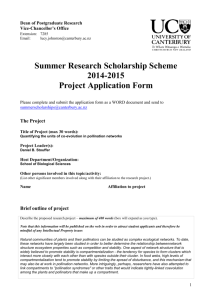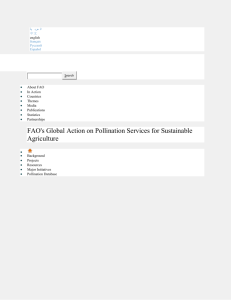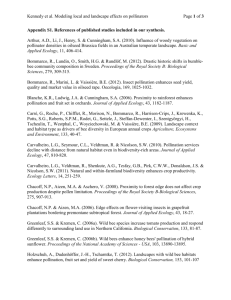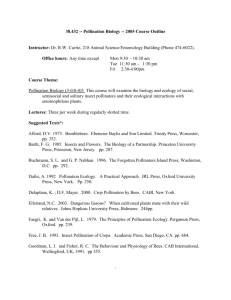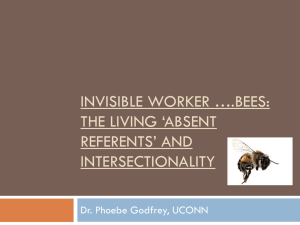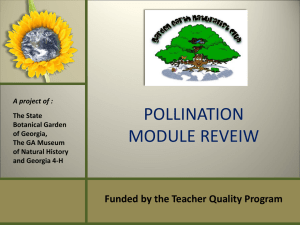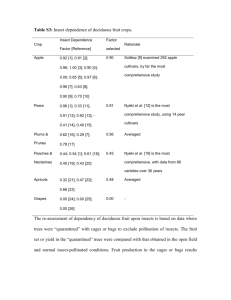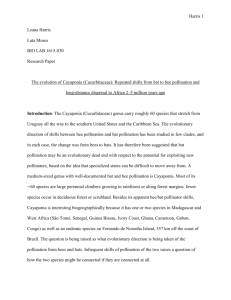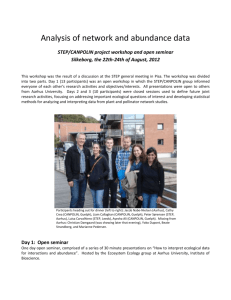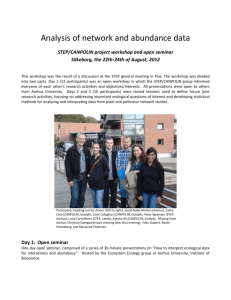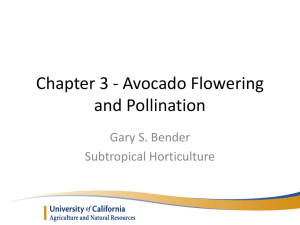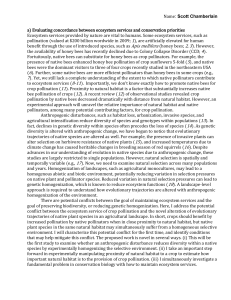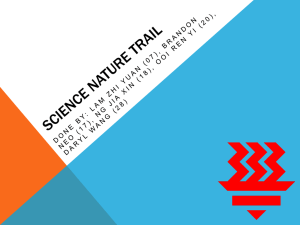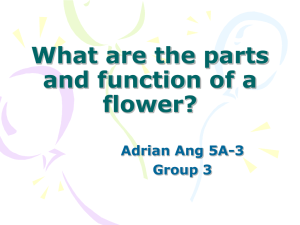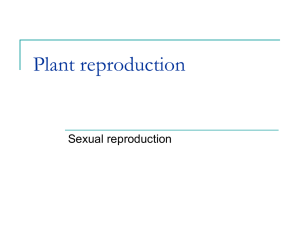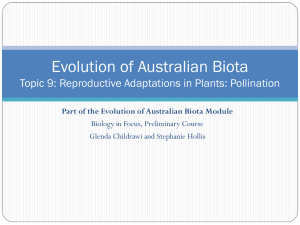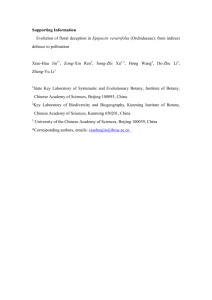Crop pollination in Norwegian Fjords and climate change
advertisement
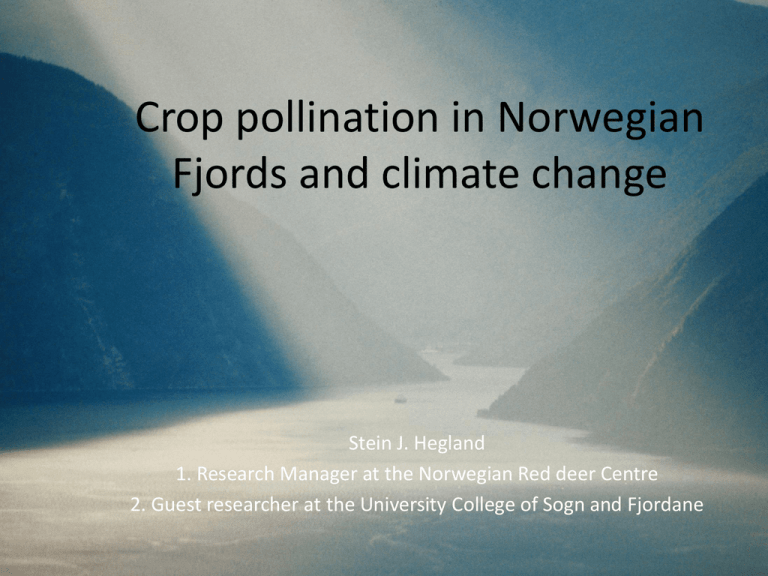
Crop pollination in Norwegian Fjords and climate change Stein J. Hegland 1. Research Manager at the Norwegian Red deer Centre 2. Guest researcher at the University College of Sogn and Fjordane My role • Involved as national partner – contribute to design and methodology etc – administrate field work(ers) and collect data – writing process • Research interest: plant-animal interaction – pollination ecology – herbivory (mainly large herbivores) • Authored conceptual review on plant-pollinator mismatches in relation to climate warming: Hegland, S.J., Nielsen, A., Lázaro, A., Bjerknes, A.L. & Totland, Ø. (2009) How does climate warming affect plant-pollinator interactions? Ecology Letters, 12, 184-195. The Norwegian Fjords • positive effects on regional climate • makes fruit production possible «close to arctic» – ca 0-100 m.a.s.l • climate gradients are strong within the fjords An example from ecological research that uses the climate gradient: SeedClim http://www.uib.no/en/rg/EE CRG/55395/seedclim • Most important Norwegian crops (in tons): 1. 2. 3. 4. 5. 6. 7. apple (11440) strawberry (9122) raspberry (2262) plums (1102) sweet cherry (537) blackcurrant (592) pears (360) Crop pollination • Pollinators are decisive or increase production in 35% (#87) of world crops • In 2005: value of insect pollination put to 153 million Euros annually (ca 10% of the total value of the worlds agriculture) • I Norway we know little, but we reckon that most of the important crops need pollination and in practise honey bees are often used as additive to natural pollinators Source: Christmann & Aw-Hassan (2012). Agriculture Ecosystems & Environment Pollination of fruit and berries Fruit Pollinators Bumblebees Solitary bees Honeybee Syrphids Other flies Apple x x x x Blackcurrant x x x Pears x x x Plums x x x x Raspberry x x x x Strawberry x x x x Sweet cherry x x x x Source: Klein et al. 2007. Proceedings of the Royal Society: Biological series Importance Large Moderate Moderate Large Large Moderate Large • Norway: apple, rasberry and sweet cherries as likely study candidates due to economics and dependence on pollinators Crop production and climate change issues in Norway • Today: Climatic sensibility to fruit production and pollination – cold and wet weather in pollination season • Climate change now and future: Increased and/or heavy precipitation: – less pollinators active + decrease in bees? – harm flowers? – increased parasite problems, especially fungi? • tunnel production is partly an arrangement to meet these challenges • Increased temperature: probably positive – better pollination and growth – more bee species in the long run? – drought issues for some crops? The Norwegian Fjords: a climate change laboratorium? • Gradients in temperature, precipitation and sun exposure (local climate) within the fruit growing area • For Fruit growing example Part of gradient the Sognefjord July mean fruit Precipitation districtExposure area temperature (°C) (mm) Lærdal Inner 14-17 ca 500 flat (valley) Luster Inner 14-17? ca 900 south-southeast Leikanger Middle 14-17 994 south Vangsnes (Vik) Outer 14-17 1138 north Balestrand Outer 14-17? 1700 southeast Earlier flowering across time Climate research challenges • Previous table highlight the importance of assessing the «real» climate gradient – not necessarily linearly related to altitude or continentality! – thus: establish the climate gradient may be important work • How link changes in pollination success to climate changes? – changes along climatic gradient is not enough! – thus: observational gradients (within + among countries) + experiments on important mechanisms? • • • • • bagging? pollen supplementation? warming treatment? precipitation teatment? etc!? • An important task for this workshop? A holistic view: crop pollination as part of the landscape is the main strenght of this project How is the surrounding landscape benefitting crop production? • Many examples on how landscape configuration, distance to and amount of (semi-)natural elements etc – affect pollinator diversity and abundance and therefore crop pollination and production • How about competition vs facilitation for pollinators among native flowering resources and crops? – Scale and distance matters, but little investigated – Applied knowledge: remove or enhance natural flower resources and on which scale? Crop pollination and changing landscapes • Semi-natural elements rich on nesting and flower resources are getting scarcer throughout Europe – a bit slower in Norway, but cultivated landscapes are turning into forest or intensified Practise I • Honey bees are used, but in varying degree depending on beekeeper abundance • Wild pollinators are relatively abundant – andplantations are relatively small – tunnels (raspberry) is a potential challenge for some pollinator species? Practise II • Apple producers often remove dandelion and other (flowering) vegetation to avoid competiton for bees (and resources) – Free, J.B. (1968) Dandelion as a competitor to fruit trees for bee visits. Journal of Applied Ecology, 5, 169-177. • Also common to remove flowering resources within plantings of other fruits and berries Scale-dependent effects of floral neighbourhood Hegland, S.J. (2014) Floral neighbourhood effects on pollination success in red clover are scale-dependent. Functional Ecology, in press Scale-dependent effects of floral neighbourhood • Facilitation of visitation to red clover at small scale changing to competition at intermediate scale and facilitation again at larger scale • Methodologically challenge: measure flower abundance at different spatial scales • Also: one need precise hypothesis. – In this study only facilitation/ competition by density of similar couloured flowers Hegland, S.J. (2014) Floral neighbourhood effects on pollination success in red clover are scale-dependent. Functional Ecology, in press Summing up • Norwegian Fjords: a potentially interesting natural climate laboratorium – in itself and in relation to other areas with distinct climate gradients – requires high quality study-design and thought-through experiments along climate gradient(s) • Both climate and landscapes are changing in these areas – both potentially positive and negative effects of climate – knowledge on climate change effects are scarce – knowledge on effects of management of surroundings and landscape change are scarce
